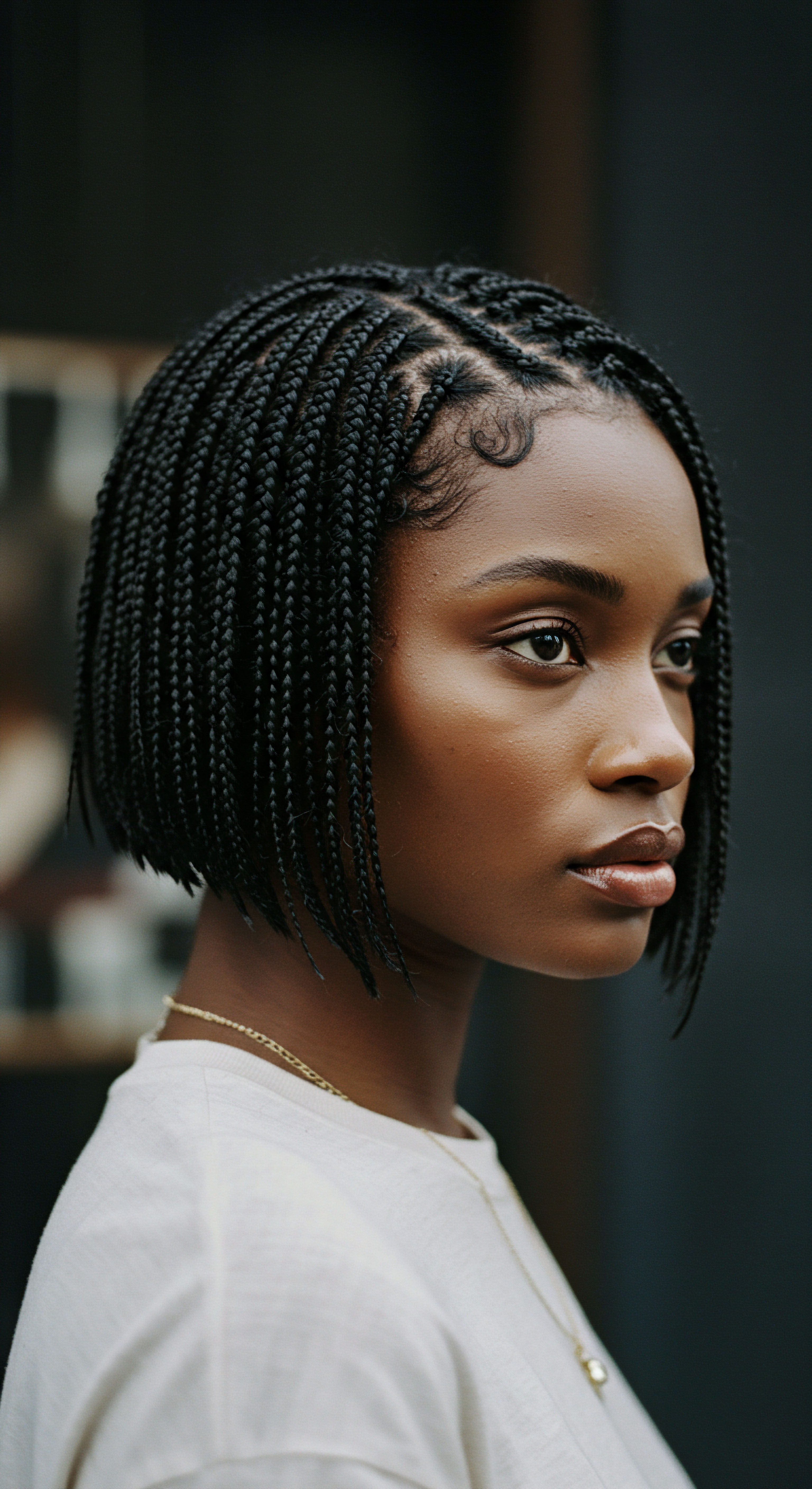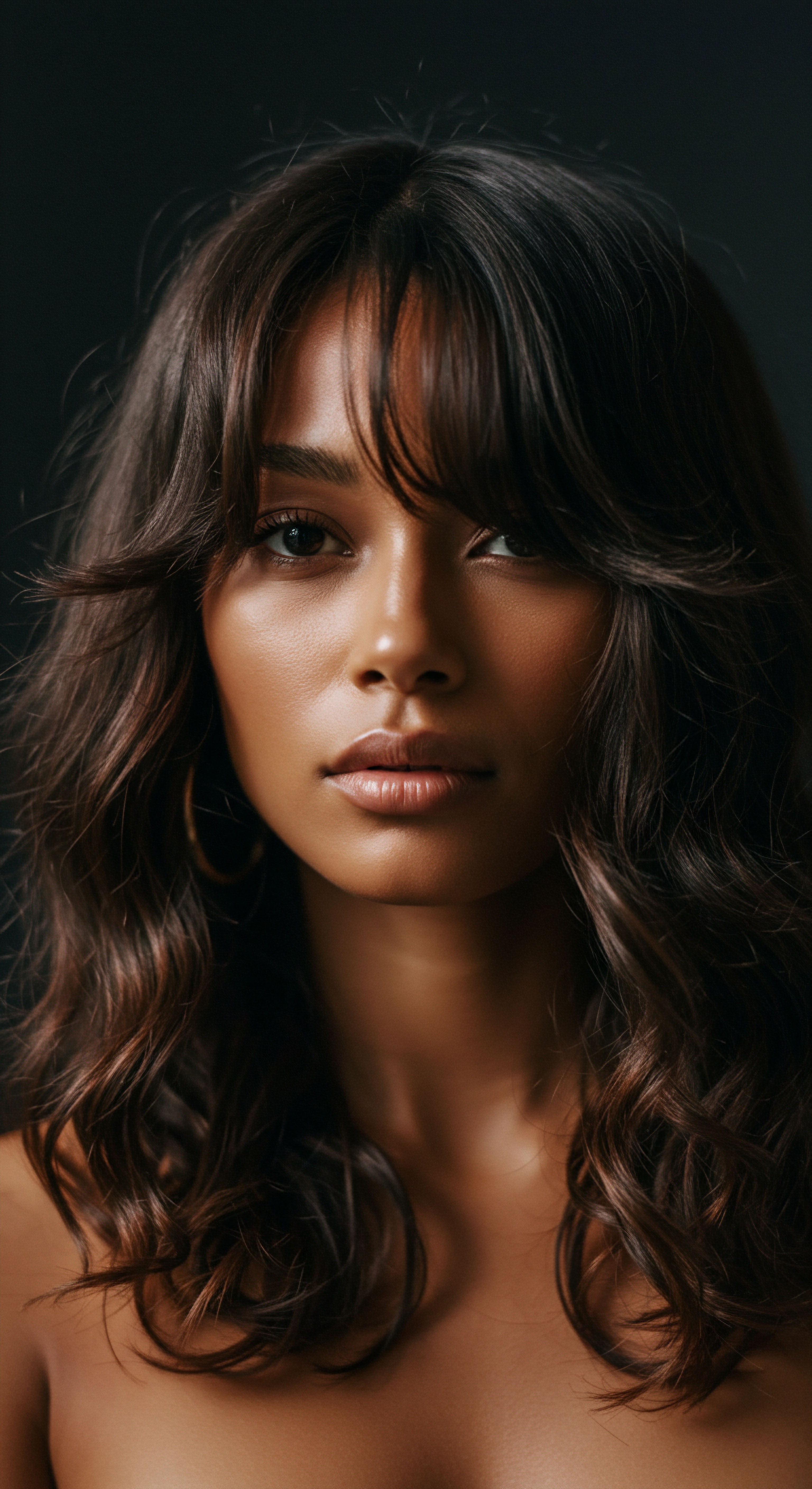
Roots
There exists a quiet hum, an ancient wisdom held within the very strands that crown us. For generations, before the advent of sleek plastic bottles and scientific compounds, humanity lived in intimate dialogue with the natural world, gleaning its secrets for well-being. When we consider the quest for hair moisture, particularly for those with textured hair, a gentle turning back of the pages reveals not a void of understanding, but a profound attunement to the hair’s inherent needs.
It is a story told not in laboratories, but in sun-drenched courtyards, beside flowing rivers, and within the comforting embrace of community. The journey to comprehend how our ancestors tended to their coils and kinks begins with recognizing the fundamental architecture of hair itself, and how these foundational insights guided their ingenious practices.

Hair’s Delicate Structure and Moisture’s Role
Hair, at its core, is a complex protein filament, primarily composed of keratin. This seemingly simple structure, however, holds surprising sophistication, especially in textured hair. The unique helical and sometimes flattened cross-sections of curls and coils influence how moisture interacts with the strand. Each hair shaft comprises three primary layers ❉ the Medulla, the innermost core; the Cortex, which provides strength and color; and the Cuticle, the outermost protective layer, resembling overlapping scales.
The cuticle’s condition plays a significant role in how well hair retains moisture. When these scales lie flat, moisture is sealed within; when they are raised, moisture escapes more readily. Traditional practitioners, though lacking microscopes, possessed an intuitive grasp of this dynamic.
The environment also shapes hair’s hydration. Arid climates, for instance, demand different approaches than humid ones. Ancestral communities, living in direct connection with their surroundings, observed these environmental cues.
They recognized that hair, like a thirsty plant, required regular, gentle replenishment, not just surface application. This deep observation formed the bedrock of their methods, allowing them to tailor care to both individual hair characteristics and climatic realities.
Ancient wisdom reveals a profound attunement to hair’s inherent needs, guided by an intuitive grasp of its delicate structure and moisture dynamics.

The Language of Hair Types
While modern classification systems like the Andre Walker Type System categorize hair based on curl pattern (e.g. 3A, 4C), traditional societies often employed a more qualitative, experiential lexicon. Their descriptions were rooted in observation of hair’s feel, its response to touch, and its visual characteristics. They spoke of hair that was “thirsty,” “springy,” “soft,” or “brittle,” terms that directly related to its moisture content and overall health.
This qualitative understanding, passed down through generations, allowed for a personalized approach to care. A grandmother could assess a child’s hair simply by touch, discerning its needs without scientific jargon.
Consider the diverse hair textures across African diasporic communities alone. From the looser waves of some North African groups to the tightly coiled strands of many West African lineages, each texture presented unique challenges and opportunities for moisture management. Traditional practices often recognized these distinctions, adapting ingredients and techniques accordingly. For instance, denser, more coiled textures, prone to dryness due to their cuticle structure and the tortuosity of the strand, received more concentrated oiling and sealing rituals.
- Hair Anatomy ❉ Understanding the cuticle’s role in moisture retention was paramount.
- Environmental Influence ❉ Practices adapted to local climate and humidity levels.
- Sensory Assessment ❉ Hair’s feel and response guided care decisions.

Ancestral Insights on Hair Growth
The cyclical nature of hair growth – anagen (growth), catagen (transition), and telogen (resting/shedding) – was implicitly understood through observed patterns of hair health and loss. Traditional communities did not possess the scientific framework to label these phases, yet their practices supported healthy growth and minimized breakage, which is often exacerbated by dryness. Scalp care, recognized as the foundation for healthy hair, was central to these routines. A healthy scalp, nurtured and free from irritation, provided the optimal environment for new hair to emerge and thrive.
For example, the application of certain plant-based concoctions to the scalp, often accompanied by gentle massage, aimed to stimulate circulation and provide nutrients. These practices, while seemingly simple, were sophisticated in their holistic approach, recognizing the interconnectedness of scalp health and hair vitality. The goal was not merely to moisturize the existing hair, but to create conditions conducive to continuous, robust growth, ensuring a legacy of strong, vibrant strands.

Ritual
Stepping from the foundational understanding of hair’s nature, we now enter the realm of purposeful action, the practices that transformed abstract knowledge into tangible care. Traditional approaches to hair moisture were seldom isolated acts; they were often interwoven into daily life, becoming rhythmic rituals that honored the hair and the individual. These were not mere applications of product, but often moments of connection – with self, with family, and with the earth’s bounty. The quest for hydration was a deliberate, consistent effort, guided by generations of accumulated wisdom and a deep respect for the materials at hand.

The Art of Oil Infusion and Sealing
One of the most pervasive and effective traditional methods for addressing hair moisture involved the generous application of natural oils. These were not simply lubricants; they served as potent emollients and occlusives, creating a protective barrier that slowed the evaporation of water from the hair shaft. Across continents, various oils became staples, chosen for their specific properties and local availability.
In West Africa, Shea Butter (derived from the nuts of the shea tree) stood as a cornerstone, its rich fatty acid profile making it an exceptional sealant. Similarly, in India, Coconut Oil, often infused with herbs, was widely used, penetrating the hair shaft to a degree few other oils could match.
The application was often methodical. Hair might be misted with water or a herbal infusion first, providing initial hydration. Then, a carefully selected oil or butter would be warmed slightly and worked through the strands, from root to tip.
This layering technique, providing both moisture and a seal, is remarkably similar to modern “LOC” (Liquid, Oil, Cream) or “LCO” (Liquid, Cream, Oil) methods, underscoring the enduring wisdom of these practices. The hands that applied these oils were often those of mothers, aunts, or trusted community members, adding a layer of care and connection to the process.
Traditional practices often layered moisture and sealants, a timeless technique echoed in modern hair care.

Herbal Infusions and Water’s Vitality
Before the rich oils, or sometimes as a standalone refresher, traditional communities often utilized water in its most potent forms ❉ as pure water, or infused with botanical wisdom. Rainwater, collected for its perceived purity, was often preferred for washes. Beyond simple water, herbal infusions served as tonics, rinses, and gentle conditioners.
In parts of Asia, Rice Water, fermented or unfermented, was a cherished secret for promoting strength and shine, its amino acids believed to condition and smooth the cuticle. In other regions, decoctions of hibiscus, fenugreek, or aloe vera were prepared, each plant lending its unique hydrating, soothing, or strengthening properties.
These infusions were not merely cosmetic. Many plants contain mucilage, a gel-like substance that provides slip and humectant properties, drawing moisture from the air. Others possess antioxidants or anti-inflammatory compounds beneficial for scalp health, which, as we considered in the previous section, is vital for overall hair vitality. The preparation of these herbal remedies was often a communal activity, a passing down of botanical knowledge from one generation to the next, solidifying the cultural significance of hair care.
The efficacy of these traditional practices, particularly the use of natural oils, has been increasingly recognized by modern science. A study published in the Journal of Cosmetic Science examined the ability of various oils to penetrate the hair shaft and reduce protein loss. The research indicated that Coconut Oil, due to its unique molecular structure (predominantly lauric acid), showed a significant ability to penetrate the hair cortex and reduce protein loss for both damaged and undamaged hair, whether used as a pre-wash or post-wash treatment.
This stands in contrast to mineral oil and sunflower oil, which were found to have minimal or no penetration. This finding provides a compelling scientific validation for the widespread historical use of coconut oil in hair care, demonstrating its tangible effect on hair health and moisture retention by mitigating protein degradation, a key factor in hair dryness and fragility.

Protective Styling and Hair’s Preservation
Beyond topical applications, traditional practices addressed moisture by minimizing its loss through protective styling. Styles like braids, twists, cornrows, and buns were not just aesthetic choices; they served a crucial functional purpose ❉ to shield the hair from environmental aggressors like sun, wind, and friction, all of which contribute to moisture depletion. By keeping the hair bundled and tucked away, these styles reduced exposure, allowing natural oils to distribute more evenly and preventing moisture from evaporating too quickly.
The longevity of these styles meant less manipulation of the hair, which in turn reduced mechanical damage and breakage. This approach reflects a deep understanding of hair’s vulnerability and the wisdom of preserving its integrity. It was a practice of patience and foresight, allowing the hair to rest and retain its vital hydration.
- Oiling ❉ Application of natural oils like shea butter or coconut oil to seal moisture.
- Herbal Rinses ❉ Use of botanical infusions such as rice water or hibiscus for conditioning.
- Protective Styles ❉ Braids, twists, and buns to shield hair from environmental factors.
| Ingredient Shea Butter |
| Traditional Use Moisture sealant, emollient, scalp soothing |
| Modern Scientific Understanding Rich in fatty acids (oleic, stearic), provides occlusive barrier, anti-inflammatory properties. |
| Ingredient Coconut Oil |
| Traditional Use Penetrating oil, conditioner, protein loss reduction |
| Modern Scientific Understanding Lauric acid content allows penetration into hair cortex, reducing protein loss. |
| Ingredient Aloe Vera |
| Traditional Use Soothing, hydrating, detangling |
| Modern Scientific Understanding Contains polysaccharides (humectant), enzymes, vitamins, minerals; provides slip. |
| Ingredient Rice Water |
| Traditional Use Strengthening, shine, growth aid |
| Modern Scientific Understanding Inositol (carbohydrate) helps repair damaged hair, reduces friction, adds elasticity. |
| Ingredient These natural ingredients offered comprehensive hair care, addressing both moisture and overall hair health. |

Relay
How do the whispered practices of old resonate in the vibrant, often complex, present? Moving beyond the practical application, this section invites us to consider the deeper currents that informed traditional hair moisture practices – the interplay of scientific intuition, cultural identity, and the enduring human connection to hair. It is a journey into the subtle yet profound mechanisms that allowed these ancestral methods to persist and, in many ways, to stand the test of time, offering lessons that extend far beyond simple hydration.

Beyond Surface Level How Did Ancient Peoples Understand Hair Porosity?
While the term “hair porosity” is a modern scientific construct, describing how readily hair absorbs and retains moisture based on its cuticle structure, traditional communities possessed an implicit understanding of this concept. They recognized that some hair textures seemed to “drink up” moisture quickly but also lose it rapidly (high porosity), while others resisted water initially but held onto it longer once hydrated (low porosity). This discernment guided their choice of ingredients and application techniques.
For hair that appeared “thirsty” or prone to quick drying, heavier oils and butters might be applied more frequently or in greater quantities, perhaps after a steam treatment to gently lift the cuticle. Conversely, for hair that felt “resistant” to water, lighter oils or diluted infusions might be favored, applied sparingly to avoid product buildup. This observational approach, honed over centuries, allowed for a nuanced, personalized moisture strategy long before scientific instruments could measure cuticle integrity.
Traditional communities, without modern terms, implicitly understood hair porosity, tailoring moisture strategies to observed hair behavior.

The Microbial World of the Scalp
A fascinating, albeit often overlooked, aspect of traditional hair care involves the scalp’s microbiome. Modern research is only now beginning to fully appreciate the complex ecosystem of bacteria, fungi, and other microorganisms that reside on our scalp and play a role in its health. Traditional practices, through their reliance on natural ingredients and gentle cleansing methods, likely fostered a balanced scalp microbiome. Many plant extracts used in rinses and oils possess antimicrobial or anti-inflammatory properties that would have supported a healthy scalp environment, thereby reducing irritation and promoting optimal conditions for hair growth and moisture retention.
For instance, the use of certain clays for cleansing, or the application of fermented substances, might have inadvertently introduced beneficial microbes or created an environment where healthy microbial populations could flourish. A healthy scalp, free from excessive dryness, flaking, or inflammation, is a prerequisite for hair that can absorb and retain moisture effectively. The ancestral focus on scalp health, therefore, served as a foundational element in their overall moisture management strategy.

The Social Fabric of Hair Care How Did Communal Practices Support Hair Hydration?
Hair care in many traditional societies was not a solitary activity but a communal one, often serving as a significant social bonding ritual. The act of detangling, oiling, braiding, or styling another person’s hair created moments of intimacy, shared stories, and the transfer of knowledge. This communal aspect played a direct, though often unstated, role in moisture management.
Consider the sheer time investment required for intricate protective styles. These often took hours, sometimes days, to complete. During this extended period, hair was meticulously sectioned, cleansed, hydrated, and sealed. The hands involved were skilled, patient, and consistent, ensuring thorough product distribution and gentle handling.
This sustained attention, impossible for a single individual to replicate on their own hair with the same efficacy, significantly contributed to the hair’s ability to retain moisture and resist damage. The social context thus provided a practical framework for rigorous, consistent hair care that directly addressed hydration needs.
Furthermore, the cultural value placed on healthy, well-maintained hair in many traditional communities created a collective incentive for diligent care. Hair was often seen as a symbol of identity, status, or spiritual connection. This cultural emphasis translated into practices that prioritized the health and vitality of the hair, including its moisture content. The shared knowledge, passed down through generations, became a living library of effective techniques, ensuring that the wisdom of moisture management was continuously relayed and refined.
| Practice Herbal Scalp Tonics |
| Direct Moisture Benefit Delivers direct hydration to scalp, conditions hair. |
| Indirect/Holistic Benefit Supports balanced scalp microbiome, reduces inflammation, promotes healthy growth. |
| Practice Communal Styling |
| Direct Moisture Benefit Thorough product application, reduced manipulation. |
| Indirect/Holistic Benefit Ensures consistent, meticulous care; fosters knowledge transfer and social bonding. |
| Practice Natural Cleansing Agents (e.g. clays) |
| Direct Moisture Benefit Gentle removal of impurities without stripping. |
| Indirect/Holistic Benefit Maintains natural oils, preserves scalp barrier, supports healthy pH. |
| Practice Traditional methods often provided layered benefits, addressing moisture alongside overall hair and scalp wellness. |

The Philosophy of Patience and Preservation
At the heart of many traditional moisture practices lay a philosophy of patience and preservation. There was no concept of “quick fixes” or instant transformations. Instead, hair care was a continuous, deliberate process, acknowledging hair’s organic nature and its need for consistent attention. This long-term perspective naturally led to practices that prioritized gentle handling, minimal heat, and the use of natural ingredients that worked in harmony with the hair’s biological processes.
This patient approach inherently contributed to moisture retention by minimizing damage. Aggressive brushing, excessive heat, or harsh chemicals strip hair of its natural oils and compromise its cuticle, leading to dryness and breakage. Traditional methods, conversely, sought to fortify and protect the hair’s natural moisture barrier, understanding that prevention was as important as replenishment. This holistic perspective, deeply rooted in cultural values and an intimate connection to the natural world, continues to offer profound lessons for modern hair care.

Reflection
As the whispers of ancient wisdom meet the hum of contemporary understanding, a compelling truth surfaces ❉ the pursuit of hair moisture is a timeless quest, one that transcends eras and geographies. The delicate balance our ancestors sought, the careful layering of botanical gifts, the communal rhythm of care – these practices, born of necessity and observation, offer more than mere techniques. They speak to a deeper reverence for the hair itself, recognizing it not simply as a biological outgrowth, but as a living canvas, a connection to heritage, and a barometer of well-being. Perhaps the most enduring lesson from these traditional ways is not a secret ingredient, but the profound value of attentive presence, gentle hands, and an abiding respect for the hair’s natural state.

References
- Rele, V. J. & Mohile, R. B. (2003). Effect of mineral oil, sunflower oil, and coconut oil on prevention of hair damage. Journal of Cosmetic Science, 54(2), 175-192.
- Gore, M. (2007). African American Hair ❉ A History of Style, Adornment, and Culture. Black Classic Press.
- Khanna, S. (2018). Ayurvedic Hair Care ❉ Ancient Wisdom for Healthy, Beautiful Hair. Hachette India.
- Okeke-Ibezim, E. (2018). African Hair ❉ Its Cultural and Historical Significance. Palgrave Macmillan.
- Draelos, Z. D. (2011). Cosmetic Dermatology ❉ Products and Procedures (2nd ed.). Wiley-Blackwell. (General hair science context)
- Robbins, C. R. (2012). Chemical and Physical Behavior of Human Hair (5th ed.). Springer. (Hair anatomy and structure)
- Holder, C. (2009). Soul Food ❉ The Surprising Story of an American Cuisine, One Plate at a Time. University of North Carolina Press. (Cultural context of traditional practices)
- Jones, A. (2008). The Science of Hair Care. CRC Press. (Hair moisture science)